

Volume 19, No. 3, Art. 35 – September 2018
Game Jams to Co-Create Respiratory Health Games Prototypes as Participatory Research Methodology
Fabio Balli
Abstract: In this article I discuss how participatory action research (PAR) and game jams can be mutually enriching activities to achieve social transformation. PAR is a collaborative method where researchers and participants go through a cycle of reflection and action to understand and solve a collective challenge. Game jams are playful events where people from different disciplines build on collective knowledge to create game prototypes. The literature review is illustrated with eleven game jams held in Switzerland and Canada to create games for respiratory physiotherapy in cystic fibrosis, and to foster self-management in asthma. Together, game jams and PAR offer attractive and inclusive contexts to ease the appropriation of interdisciplinary knowledge, develop leadership and social skills, and foster civic engagement.
Key words: community-based participatory research; knowledge transfer; participatory action research; games for health; free/libre and open source software
Table of Contents
1. Introduction
2. Theoretical Framework of Participatory Action Research
3. Health Game Jams
4. Participants as Equals
5. A Welcoming, Inclusive Space
6. A Facilitated Co-Creation Process
7. Integrating a PAR approach within Game Jams
8. Value of Game Jams as Research Method
9. Ethical Behaviors for All
10. Discussion
11. Conclusion
In January 2014, a colleague, Yannick GERVAIS, and I decided to create digital games to promote health as part of our game design studies. After meeting clinicians, we agreed to create prototype games that may help children affected with cystic fibrosis with their daily treatment. The goal was to transform daily respiratory physiotherapy into a fun, rewarding experience. For that, we used a pressure sensor to transform the breath into a game input, building on the work of a product design student—John DANGER. We realized three prototypes by the end of our study in February 2014, and co-organized a pilot clinical study to get feedback from ten children. [1]
To mobilize further contributors, our small team took part in "hackathons," events, generally of two days, where experts and newcomers from different fields collaborate to produce a demonstration of software. We carried out these hackathons in the summer of 2015, and pursued prototyping, while developing new game concepts. [2]
I then organized our own co-creation events, which we called "health game jams" to emphasize collaboration. From August 2015 to April 2018, we held eight events in Montreal, Canada, and three in Geneva, Switzerland. We mobilized about 250 participants, who co-created 15 game prototypes, covering cystic fibrosis therapy, education to prevent asthma crises, and respiratory health promotion. This initiative became the "Breathing Games" commons, which I coordinate. [3]
Essential to the co-creation were: 1. the will to document and share the work done so that interested people could reproduce and build on it (free/libre and open source licenses); 2. a cyclic development process to rapidly implement previous learning; 3. the intention of inclusiveness to value transdisciplinarity: going beyond the perceived separation of disciplines. [4]
These elements are quite similar to the values fostered by participatory action research (PAR); a "powerful strategy [that ...] involves practitioners in [a] research process from the initial design of the project through data gathering and analysis, to the final conclusions and actions arising out of the research" (WHYTE, 1991, p.7). [5]
I wrote the present review of literature and practices after having organized ten game jams. Hereafter, I present the framework of PAR, the practice set up for health game jams, and aspects common to both: the role of participants, space, co-creation, and data. I then show the value of integrating research in game jams, with ethics-oriented elements. Finally, I propose a discussion about future opportunities and threats, as well as concluding words. I do not criticize PAR or discuss other research approaches; my intention is to show how PAR and game jams can mutually enrich. [6]
2. Theoretical Framework of Participatory Action Research
PAR is a qualitative methodology that fits within constructivist and social psychology perspectives. It aims at describing and understanding the characteristics, patterns, and meanings of human experiences rather than predicting and controlling them (MacDONALD, 2012). PAR can be related to community-based participatory research or integrated knowledge translation (JULL, GILES & GRAHAM, 2017). [7]
PAR builds on the work of Kurt LEWIN (1946) on action research, and by others on participatory methodologies, and emancipation movements (GREEN et al., 1995; HALL, 1984; MacDONALD, 2012). PAR influenced Paulo FREIRE's (1970) work on critical pedagogy (MacDONALD, 2012; RIECKEN, STRONG-WILSON, CONIBEAR, MICHEL & RIECKEN, 2005). [8]
To undertake PAR is to do a social investigation; to educate and act to achieve social transformation with the participants rather than on or for them (BALCAZAR et al., 2004; KINDON, PAIN & KESBY, 2008a). It consists of "learning how to explain a particular social world by working with the people who live in it to construct, test, and improve theories about it, so they can better control it" (ELDEN & LEVIN, 1991, p.131). Indeed, PAR assumes that neutrality is neither possible nor desirable since everyone has his or her own reality, built on specific contexts (LAW, 2004; MacDONALD, 2012; MANZO & BRIGHTBILL, 2008). [9]
In this approach, knowledge is co-produced by researchers and participants through a cycle of reflection and action which requires participants to share their beliefs about and experience of a topic (BERGOLD & THOMAS, 2012). In practice, the participatory process is as important as its outcomes (MANZO & BRIGHTBILL, 2008); as the process makes the distribution of power and contributions visible. [10]
In regard to ethics, PAR practitioners consider it inadequate to observe suffering without acting; as MANZO and BRIGHTBILL (2008) write:
"most social researchers believe themselves to have behaved ethically if they have had no negative or perceivable impact [...] Simply doing no harm [...] neglects the privilege[s] that enable researchers to observe but choose not to become 'involved'. [… PAR encourages] participants to generate benefits for themselves" (p.35). [11]
Hence, researchers should commit with their hearts and minds to nurture a cooperation of quality; and participants should be as actively involved as they can to increase their autonomy, by developing their own consciousness and knowledge (RAHMAN, 1991). For BERGOLD and THOMAS (2012), doing participatory research is "a litmus test for a society's democratic self-concept" (§10). [12]
As a result, PAR can empower participants through a new understanding of social realities and human potential. PAR increases one's capacity to learn how to learn from others by engaging in intense dialogue (BALCAZAR et al., 2004). By building participants' capacity to value their creativity and to make meaningful decisions, the approach also enables change at collective levels (ibid.). [13]
Many similarities can be found between the philosophy promoted by PAR and the practice developed during the game jams. Game jams are generally not competitive, but associated with a collaborative environment, similar to that of musical jam sessions. They build on creativity and playfulness. Sometimes, game jams are organized around specific issues, such as health or social inclusion, in order to value social impact (DECKER, EISELT & VOLL, 2015). [14]
The purpose of organizing game jams about respiratory health is to enable participants to design their own health promotion and disease prevention tools. By building on collective knowledge, participants can deepen their awareness about their own, and their neighbors' health in a whole-system approach (GREENHALGH, 2009). [15]
Several game jams dedicated to health are described in the literature, which took place before the events I present in this article: the BuildHealth Hackathon in 2012 mobilized 34 people to address community health issues (HILDEBRAND, 2012); the CDC Games for Health game jam mobilized over 300 people in 2013 to develop 30 games addressing winnable battles in public health (PRESTON, 2014); the Apps for Healthy Kids game jam in 2014 which aimed to address childhood obesity across USA (SHIN et al., 2012). [16]
The eleven game jams we organized took place during two to four days. For each event, between 15 and 30 newcomers and experts attended, mostly professionals (visual artists, software developers, game designers, electronics engineers, sound composers, coordinators, communicators), and each time one to three clinicians (a physiotherapist, a pulmonologist, a public health specialist). Generally, a few participants were either affected by a chronic respiratory disease or had someone in their family who was living with it. [17]
The first events were focusing on helping children affected with cystic fibrosis do their daily physiotherapy. In 2016, as we were not able to mobilize the children or their parents, we moved to asthma prevention and care. Since 2018, we have been working on respiratory health promotion to raise awareness on respiratory health before symptoms appear. [18]
Several kinds of gameplay—the rules of the games that inform the player experience—were collectively designed by the game jam participants.
Seven prototypes (sidescrollers, puzzle, tower defense, point-and-click, narration) aim to ease the daily physiotherapy that children who have cystic fibrosis do to release the mucus in the lungs: The games use a breath-pressure-based controller to give visual biofeedback to the player. For example, the player drives a spaceship towards a destination—breathing in makes meteorites appear in front on the vessel, and breathing out allows to shoot at them with a laser.
Three prototypes (sidescrollers) strive to motivate children to regularly self-assess their lung capacity: The games use a breath-flow-based controller to give visual biofeedback to the player. For example, the player blows intensely three times so that Easter statues 1. destroy buildings, 2. plant seeds, and 3. make rain to reinstate nature.
Three prototypes (point-and-click, Tamagotchi (virtual pet), character customization) seek to teach children how to prevent and manage asthma crises (triggers, signals, medication use, etc.): For example, the player collects objects and combines them to open doors and help characters be healthy.
Two prototypes (augmented reality, toy) target to raise awareness about respiratory health: For example, the child watches a poster through a mobile application, and plays a small game that explains how an air molecule is heated when going through the lungs. [19]
I describe the games on cystic fibrosis in another article (BALLI, 2018), and will present the games on asthma in an article to come. [20]
The game jams also allowed us to work on the financial viability and on community targeted communications about the initiative. The method for making the initiative financially sustainable was also better defined—as the games and the design of hardware are made freely available. By doing this, anyone is able to use and adapt the work so that it fits their needs.
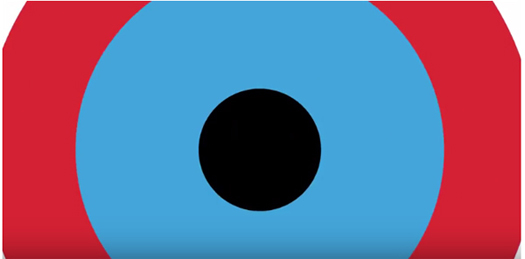
Video 1: Summary of a game jam held in Geneva in 2016. Please click here to access Video 1
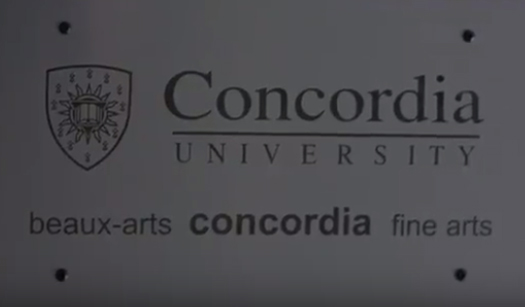
Video 2: Summary of a game jam held in Montreal in 2017. Please click here to access Video 2 [21]
In the following sections, I propose to explore how these events intersect with PAR in regard to participants, places, and process. [22]
What distinguishes PAR from mainstream research approaches is the idea that scholars and participants work together in carrying out the research. PAR reflects the first article of the Universal Declaration of Human Rights: "All human beings are born free and equal in dignity and rights. They are endowed with reason and conscience and should act towards one another in a spirit of brotherhood." [23]
PAR recognizes the need for participants to be part of the solution, in order for it to be sustainable. Participants are capable of deliberating and making meaningful decisions for their lives and environment. They should be heard and not made anonymous, as the latter reduces their visibility to the benefit of the researcher. Every participant should be respected and valued for her or his uniqueness and contribution: all voices together create more than the sum of each individual, maximizing the positive outcomes for all stakeholders and for society (MANZO & BRIGHTBILL, 2008). Hence, research can be democratized as a way to understand and make the world a better place. [24]
Game jams and PAR tend towards similar values. COOK, SMITH, THOMPSON, TOGELIUS and ZOOK (2015) describe them as something that
"brings together people from different disciplines to collaborate in an intense and focused environment. [...] Building games and other playable experiences is a reflective process, allowing the designer(s) to deeply investigate [...] concepts concrete[ly through] the game's design" (p.2). [25]
Indeed, there are no prerequisites for participation—anyone is welcome. For game jams on respiratory health in particular, everyone can relate to the experience of a respiratory disease. By taking part in these game jams, people may learn how to preserve their own good health and how to improve their community's air quality by learning how not to pollute. For people who are ill, the involvement of their relatives is also essential to their care (GREENHALGH, 2009). [26]
Creating games can be enjoyable for newcomers. Even without technological knowledge, participants usually want to learn in order to belong to the group (TAVARES & ROQUE, 2007). In fact, the context of the game jam invites every participant to build on others’' knowledge. Thus everyone "must represent their own constraints and respect each others' [constraints]" (COOK et al., 2015, p.2). Involving various stakeholders such as researchers, policy-makers, educators, economists, and users are critical for developing games for health (ARPOLA & HOLOPAINEN, 2014). This is similar to PAR, where the people concerned about the issue should be actively engaged (BERGOLD & THOMAS, 2012). [27]
For the game jams we organized, participation was open to everyone. However, we communicated mostly through specific channels, such as online groups dedicated to respiratory health patients and people interested in games. I organized all events with the support of different contributors, combining appropriate means (available place and supporting people), a practice of facilitation, and building health knowledge from event to event. [28]
We involved patient associations, hospitals, universities, and networks of professionals before the events to ensure that key actors would be represented. Medical care professionals also helped us in defining key messages to deliver in the games.
Illustration 1: Self-organizing teams during two game jams. Please click here for an enlarged version of Illustration 1 [29]
5. A Welcoming, Inclusive Space
As outlined above, the setting constitutes an important element of the "safe space" required in PAR to enable sufficient openness from the participants. A welcoming, inclusive, and accessible space is also important in game jams to enhance their social dimension. According to DECKER et al. (2015), a warm atmosphere without prizes or competition, which fosters gender-neutral communications, and features healthy foods, may help involve more people, and thus enable them to feel part of a group which shares similar interests. Practical elements such as wireless internet, meals, snacks, drinks, whiteboards, prototyping material, additional computers, a locked space, and sleeping options are always appreciated by participants (HANSSON, 2014). [30]
The setting was relatively similar in all game jams. The events in Switzerland took place during an international event dedicated to innovation and prototyping. These events were held over three to four days in downtown Geneva, Switzerland. Two zones were provided: an open space with seats, tables and bulletin boards, and a space in a prototyping lab, with seats, whiteboards, and movable elements. Food was provided. The event in Canada ran for two days in a modern, adaptable space at a university in downtown Montreal, Canada. The space included a classroom, and a working lounge. Food, a sleeping option, as well as computers and tablets, were provided. In both cases, documentation about the schedule, goals, and resources available was provided in advance.
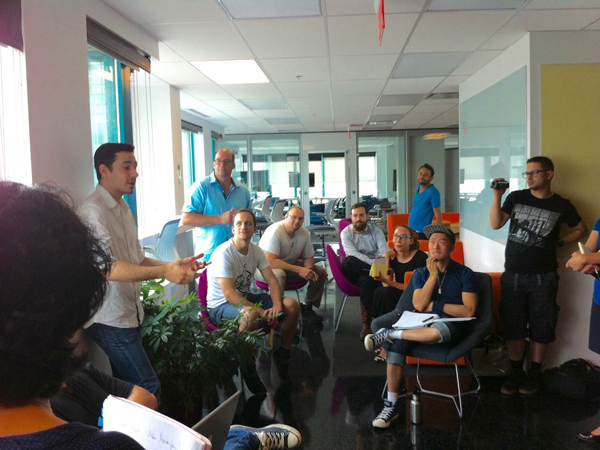
Illustration 2: Setting of a game jam held in Montreal
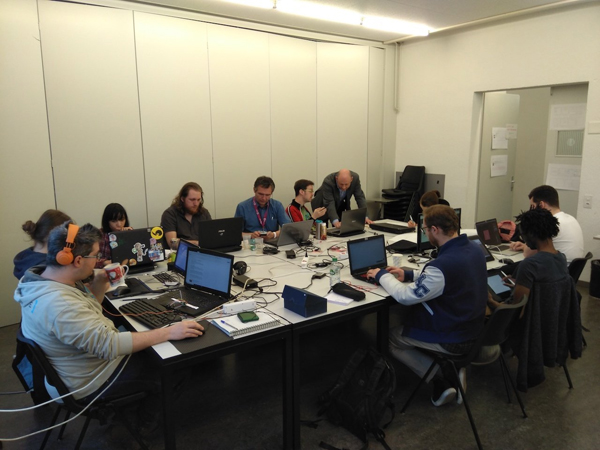
Illustration 3: Setting of a game jam held in Geneva [31]
6. A Facilitated Co-Creation Process
For KINDON, PAIN and KESBY (2008b), PAR "values the processes of research as much as the products, so that its 'success' rests not only on the quality of information generated, but also on the extent to which skills, knowledge and participants' capacities are developed through the research experience" (p.13). Implemented well, the methods used should "embody the process of transformative reflexivity in which both researcher and participants reflect on their (mis)understandings and negotiate the meanings of the information generated together" (p.17). [32]
In practice, the participants should be able to trust each other, self-reflect, express their views, and take part in decisions (BERGOLD & THOMAS, 2012). The facilitators should provide guidance to the participants so that the latter co-create meanings for the information generated throughout this transformative process (BALCAZAR et al., 2004). According to RIECKEN et al. (2005) they should also offer participants "a space where it is safe to be who they are" (§13), connect people with their heritage, create a sense of belonging, and increase their autonomy. [33]
Once more, similarities with the mindset of game jams can be found. MUSIL, SCHWEDA, WINKLER and BIFFL (2010) describe game jams as a "reflective team activity [whose] design com[es] from a reflective, know-how bricoleur, self-organizing system [...]. The end product is the result of [...] a reflective conversation that presents a solution to a unique, situation-based problem" (p.184). [34]
In practice, game jams generally last between 24 and 48 hours; with a short or long break to sleep or rest according to the group dynamics, and to the sleeping options provided. The playful process at the heart of the events fosters learning and innovation (DECKER et al., 2015). Thematic and temporal constraints, as well as the support from returning participants can also motivate newcomers to join and experiment (COOK et al., 2015; ITO, 2005). [35]
One major step at the beginning of a game jam is the creation of teams. PIRKER and VOLL (2015) present two ways of forming groups: one invites participants to join ideas that are pitched, the other invites them to build teams before defining a project. They suggest that the latter is the better choice for small events. [36]
Once the teams are built, the ideas must be implemented into gameplay. According to ZOOK and RIEDL (2013), different approaches are possible: "starting from many ideas and iteratively reducing scope; starting from vague ideas and building up mechanics and ideas through implementation; and starting from a core idea and building it up based on testing and feedback" (p.3). Over time, games are fine-tuned through a cycle of prototyping. This cycle is key to game jams as they enable one to learn from his or her mistakes, and improve the game prototype in a very short time, which enables a better play experience. A study by DOW, HEDDLESTON and KLEMMER (2009) shows that participants who work iteratively on a new task perform as well as participants who work non-iteratively on a known task. [37]
Similarly, to this recurring process, PAR builds on a continuous cycle of reflection and action. This process enables participants to document their work, and adjust their needs with those of their peers (MacDONALD, 2012). The scope of the game jams also enables participants to explore new concepts, to take risks and address challenges they would not have in another context (COOK et al., 2015). [38]
In the game jams we held, the facilitators worked with physicians and therapists before the events to gather data and define health elements to include in the games: respiratory exercises to be done, important messages to remember, ways of measuring health outcomes, and so forth. We provided this information to all participants at the beginning of the events. We set an inclusive dynamic to enable participants to learn from each other, build teams, decide which kind of games they would create, and how they would integrate the information provided. For most of the event, the participants self-organized, and we remained available as resource persons. Once to four times a day we invited participants to come back in a bigger group to share their advances, challenges, and to learn about other teams. [39]
I built this facilitation based on BERNE's organizational theory (1959), which offers a set of methods to observe the dynamics in a group; CLARKSON's (1991) constructive leadership behaviors; and LAUGERI's (2015) three-contracts methodology. The latter proposes a simple method to develop a healthy dialogue between leaders, driven by the performance of the group, and group members, driven by the passion for the activity. My goal was to set the right level of challenge for the competences available in order to help the group achieve flow: "[T]he state in which people are so involved in an activity that nothing else seems to matter; the experience itself is so enjoyable that people will do it even at great cost, for the sheer sake of doing it" (CSIKSZENTMIHALYI, 1990, p.4). [40]
In the following illustration, I show how the facilitation process builds on TUCKMAN’s (1965) stages of group development, from the arrival of participants, where people invest little energy and do rituals, to the end of the event, where people divest their energy to move on to another activity. I co-facilitated all events with one or two other contributors.
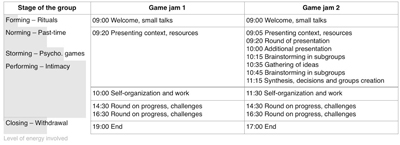
Illustration 4: Overview of the facilitated process during game jams. Please click here for an enlarged version of Illustration 4 [41]
7. Integrating a PAR approach within Game Jams
In PAR, three different methods should be used to consolidate data. The most common are focus groups, participant observation, and interviews (MacDONALD, 2012). BERGOLD and THOMAS (2012) suggest that participatory methods should build on participants' lived experience so they can understand and take ownership of the research. RIECKEN et al. (2005) add that feelings should be considered in gathering data: this is not "to investigate something that lies outside of [the participants]. This is about who they are and about giving back to community" (§37). Methods should encompass sentiments and emotions by engaging lived experiences, embodied knowledge, and the use of new media (FALS-BORDA, 1991). [42]
Thus, documenting the lived human experience, through different media, is an important asset. Reports, newsletters, or videos can be used to make the development of competencies visible to both the researchers and the participants (PAIN et al., 2008). For LINCOLN (1995), "[t]he extent to which alternative voices are heard [is] a criterion by which we can judge the openness, engagement, and problematic nature of any text" (p.283). [43]
In the literature on game jams, there is very little emphasis on documentation, except HANSSON (2014), who proposes a voting method to make decisions. One reason may be that documentation is a byproduct of the game jams. This may also relate to the fact that a majority of participants take part in these as a one-time event; there is no plan to continue to work on the prototypes developed. However, inviting participants to consider the game jams as a source for research, and asking them about how all the data created collectively could be used, may bring game jams to another level of interaction. In fact, this could add a further level of understanding through observation and feedback for:
creating a game,
playing while creating the game,
researching while playing while creating the game. [44]
Because the game jams hosted were part of a broader initiative, participants were aware that documenting was important to enable a reuse of the work they created. We also improved the preparation of the events over the years, and adopted different online tools to ease collaboration and ensure traceability of the contributions. This was set mainly by long term contributors. [45]
Tools that we actively used during the game jams are described hereafter, with examples.
Documentation was mostly done on Google Drive, which enables different users to edit texts, spreadsheets, and presentations simultaneously. For the game jams, the facilitators created most documents, and participants completed them (for example promotional flyers, abstracts from medical literature, documents used by health professionals, game design document, images taken by participants, articles for congresses).
Source code of the games and devices was registered on GitHub and later on GitLab (the latter being a free/libre version), a hosting service for software development that includes version control and access management systems. Most participants used this tool, as it enabled them to work simultaneously on the content of games and devices, without the risk of losing their individual work; for example, content produced by the game engine including code, images, sounds, and animations.
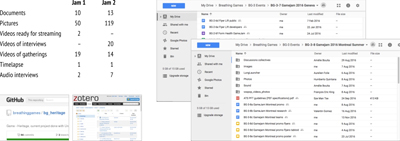
Illustration 5: Examples of documents created during game jams Please click here for an enlarged version of Illustration 5
Contributions were logged into the Sensorica/Mikorizal Value Accounting System, a free/libre platform which enables a group to document contributions in time, material, and money; validate outcomes from peers; see the collective effort; and have funds redistributed via an algorithm. This system is key to the initiative, as it enables everyone everywhere to contribute to the project, and be acknowledged for their contribution. This makes collaboration more attractive than competition, as participants build on each other’s work instead of contending for an award; for example, 5 hours used for design and coordination, $25 pressure sensor bought, $100 donation received.
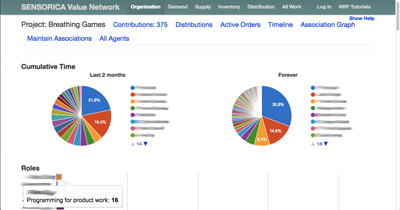
Illustration 6: Examples of contributions registered for game jams Please click here for an enlarged version of Illustration 6
Ambience and dynamics were captured through pictures, videos, and audio recording done by facilitators and participants. Time-lapse videos (pictures taken every n minutes and shown in fast-motion) were also done. In the second game jam, short interviews were done with participants to document their experiences, which were then broadcast online. This turned out to be an added value for all: an acknowledgment and new experience for participants, and a means to increase visibility for the initiative and its supporters. This gives voice to everyone, not only within the project or for research purposes, but also making the work accessible on the Internet. Participants could also be invited to film their own interviews and sequences. This fits with PAR practices where "experience has shown that, after appropriate training, the various research partners are well able to conduct these interviews" (BERGOLD & THOMAS, 2012, §67).
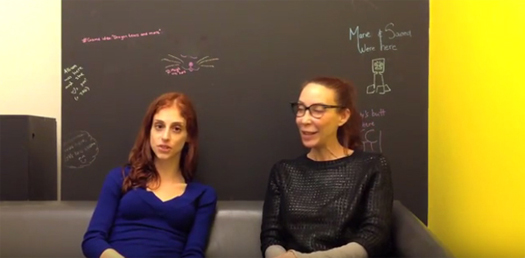
Video 3: Interview with participants after a game jam. Please click here to access Video 3
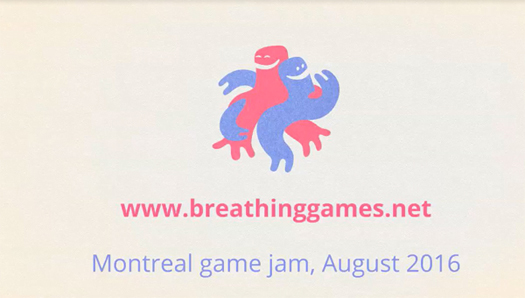
Video 4: Interview with a pulmonologist after a game jam. Please click here to access Video 4 [46]
To summarize, documenting the game jams, and discussing with participants how these data can be valued—as PAR proposes—could make the collective work accessible beyond the event, allowing to enhance and research the co-creation process. [47]
8. Value of Game Jams as Research Method
Game jams offer an affordable, effective experience to innovate, practice agility, rapid prototyping—creating a functional draft of a product in a few hours—, and develop skills in collaboration with end users (ARPOLA & HOLOPAINEN, 2014; DECKER et al., 2015; MUSIL et al., 2010). Participatory interdisciplinarity enables participants to "break [...] down barriers between traditional knowledge roles (researcher/stakeholder) and knowledge forms (academic/local) and in activating more integrated environmental management" (O'BRIEN, MARZANO & WHITE, 2013, p.51). [48]
Through the continuing, reflective conversation happening during game jams, a pragmatic solution to a specific problem can emerge (MUSIL et al., 2010). In addition, as participants do not aim for profit, they are free from the constraints of professional environments. They can build on their interests, and tends to value the arts while putting aside the race for the latest technology and the most sales (ITO, 2005). Nonetheless, some constraints exist in the case of games for health. The integration of specific therapy patterns, health promotion messages, or the customization and follow-up of one's health condition. Finding a balance between the assessment elements and playfulness is a major challenge in educational games. However, the participation of physicians and therapists also enables different positive outcomes: participant awareness of health challenges increases, and the emergence of long-term collaborations. [49]
For researchers beyond the interdisciplinary creative experience, these events provide a supportive environment where they can build proof-of-concepts, present their academic work, and have a constructive dialogue about new research avenues (COOK et al., 2015). Older researchers can also acquire knowledge about subcultures young researchers possess and nurture a relationship with them (HIGGINS, NAIRN & SILGO, 2008). In fact, game jams are a new way of doing research as COOK et al. (2015) point out that academic meetings generally focus on work already completed:
"Game jams offer an alternative [to...] create something in a short time frame by combining [interdisciplinary] skills and knowledge in ways that are hard to do with traditional long-term research projects. [These] can produce 'playable research': practical demonstrations of theoretical ideas" (p.1) [50]
For students, participating in game jams enables them to develop a different set of skills, and encourage networking with professionals and peers. Such events can also "help overcome some of the risk aversion so common to academic study" (p.2), and prepare students beyond the classroom (SHIN et al., 2012). Indeed, as SCOTT and GHINEA (2013) propose: "The emphasis [...] on peer-supported practical activity and collaboration, represent[s] a refreshing change from the traditional pedagogies [...] learning from industry practitioners is rather attractive [...] the discourse and critique that is often encouraged between teams is appreciated" (p.1). [51]
In fact, though game jams are rarely seen as part of an academic curriculum (COOK et al., 2015), PRESTON, CHASTINE, O'DONNELL, TSENG and MacINTYRE (2012) showed "a positive correlation between game jam participation and academic performance" (p.68). For FOWLER, KHOSMOOD, ARYA and LAI (2013), "[s]tudents who do not attend game jams have a lower GPA [grade point average] than the average GPA of their peers" (p.4). Furthermore, the social skills required to realize, with anonymous persons, a playable game during a weekend can be easily translated into different domains and jobs. Iterative prototyping is one of the skills that could be valued in professional activities, especially for complex projects (MUSIL et al., 2010). Thus, game jams could "inspire new forms of teaching activities and problem based learning" (RENG, SCHOENAU-FOG & BUSK KOFOED, 2013, p.7). [52]
In the first game jam for example, about 410 hours were spent together by 30 participants over three days. In the second game jam, 26 participants invested about 315 hours together over a weekend. The documentation produced—the videos and interviews in particular—provides a sneak peek into the human experience lived in such an activity. This could also become valuable research data for PAR, and be a topic for a publication collectively written by game jam participants.
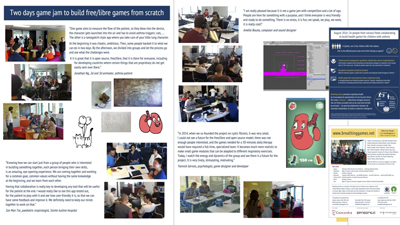
Illustration 7: Synthesis released after a game jam Please click here for an enlarged version of Illustration 7 [53]
As outlined, the practice upon which PAR could be activated already exists within the form of the game jam. Indeed, the values underlying these events and how they take place offer a rich ground for PAR. However, "a desire to represent and work with participants as co-equals cannot in itself negate existing power differentials" (RIECKEN et al., 2005, §1). [54]
Thus, participants should not only be asked if they accept that the data collected previously is used for research purpose, but they should also decide with the researchers how the study should be conducted, and how data are used. Some of the elements to clarify are (BERGOLD & THOMAS, 2012; MANZO & BRIGTHBILL, 2008):
roles, responsibilities, and availability of the people,
collection, documentation, and interpretation of data,
decision-making process,
protection of privacy,
fair distribution of benefits,
limitation of the risk of revealing vulnerabilities. [55]
Indeed, PAR goes beyond traditional ethics as it considers that both researchers and participants should behave ethically as they co-create, and are thus co-responsible for their relationship. An ethics research protocol, which assesses the risks related to the study, would have to be submitted and approved before the data collected could be used for research. [56]
This article arises from an intersection of two emerging research fields: PAR and game jams. If permission is given to use the data for research, further reflection is required on how to analyze them, and how participants could take an active role in the research. In that regard, BALCAZAR et al. (2004) propose to take into consideration "the degree of control that participants have over the research process [...], the extent of collaborative decision making between participants and professional researchers [...] and the levels of input from and commitment of participants with the research process" (p.18) Questions such as how the flow and autonomy of the participants evolve during the game jams could be studied. [57]
The relation between PAR and the research protocols prepared to test the games should also be taken into consideration. How to include these results in PAR could be discussed with participants interested in contributing to the research. A deeper understanding of the literature about participatory health methods as well as mixed methodologies would also be relevant. [58]
Particular attention should be also paid to the sharing of responsibilities: experts in participatory processes should help the group make their decisions rather than using their authority for their own prestige (KOTHARI, 2005). Another focus of attention is to avoid the appropriation of the research by institutions to achieve political agendas (RAHMAN, 1991). Indeed, "if research informs policy, but is removed from the voices of the stakeholders affected by such policies, then what is its point, except to maintain the privileged positions of experts in government and universities?" (RIECKEN et al., 2005, §32). PAR also implies a polarization between action and research, and may not take into account how learning itself emerges in a community (FENWICK, 2000). [59]
A further element to consider is the low acceptance of PAR as a legitimate approach when it comes to receiving research funds and to publishing articles written with participants (BERGOLD & THOMAS, 2012). The time required to collectively produce articles and application grants also can have an impact on the researchers in relation to their performance assessment. More positively, as the research is related to collectively managed resources (commons), other sources of funding may be provided, if not for the research, then for the community. [60]
In regard to the game jams, different elements listed in the literature could be implemented:
organizing a pre-jam festive party (RENG et al., 2013),
visualizing the progress of the teams during the game jams to create a narrative (TURNER & OWEN, 2013),
enriching the interviews and the research proposal with questions prepared in other events (FOWLER et al., 2013; RENG et al., 2013),
ensuring the inclusion of people that are not at ease with technologies (SCOTT & GHINEA, 2013),
fostering the online creation, and thinking how the game production could be made easier to "elevate games as a truly participatory medium" (TAVARES & ROQUE, 2007, p.2). [61]
The literature reviewed and discussions with researchers also opened further topics that could be explored: research through design, design game, multimodality, human-computer interaction, do-it-yourself and maker practices, fan-based production, sketching user experiences and semantic turn. [62]
TAVARES and ROQUE (2007) ask: "in a world where everything is more and more connected, and collaboration is essential, why not allow the creation acts to happen online at the same time that players are actually experimenting with the game?" (p.5). The topic presented may draw a multi-layered answer: health game jam participants while creating and experimenting games, immerse in play at a higher level. They are in this "magic circle" (HUIZINGA, 1938, p.10), learning through the group, developing their autonomy. They are not only recognized as part of a community, but they also commit to solving a common challenge the community faces collectively. [63]
"PAR demands that academics bridge the worlds within and beyond the academy" (PAIN et al., 2008, p.31). As presented, many elements from game jam practices are congruent with PAR. Allying the two approaches may enable an association of participation and research methodologies with playfulness, facilitation techniques, and enable the citizens to take ownership of a research-backed creative process. [64]
Since 2014, a fundamental motivation for our initiative has been to create a sustainable socioeconomic practice, where people from different disciplines, organizations, and countries share their knowledge to solve major challenges of society, such as reducing the burden of chronic respiratory diseases which affects one person out of five in the world. [65]
Over time, an intuition evolved and emerged as a research question: How can respiratory health be improved internationally by acknowledging the work of citizens who create and contribute to freely accessible educational games for health? In hindsight, expressing this question already transforms a utopia into a specific, measurable phenomenon that can be researched. [66]
Similarly, the strong ties that seem to exist between the game jams and PAR only appeared while I wrote this article. We did not organize game jams to do PAR, and the reflection on PAR did not start as an intention to observe game jams. In fact, the practice and the research seemed to emerge and intersect simultaneously, arguably because of similar values. This sheds light on LAW's (2004) statement that methods "not only describe but also help to produce the reality that they understand" (p.5). In this case, a reality—the game jam—may help to produce and understand PAR. [67]
However, one could correctly argue that game jams are not PAR yet; no social contract has emerged from a common intention from the participants to do and be subjects of research. Furthermore, even if substantial, valuable data was collectively created and made freely available, the research proposal and the use of data for this purpose also needs to be accepted by participants, and secondarily by research authorities. [68]
LAW (2004) invites us to break free from
"the desire for certainty; [...] stable conclusions about the way things really are; the belief that as social scientists we have special insights that allow us to see further than others […] we need to unmake our desire and expectation for security" (p.9). [69]
In fact, he says that, as methods produce realities, morals and have political implications, researchers need to embrace the fact that methods only enable them to capture a partial perspective of complex realities, which cannot be fully grasped. Thus, research results should be seen as a symbolic representation of a specific, context-related reality. Games create a "magic circle" where players experiment and learn while having fun (HUIZINGA, 1938, p.10). What if PAR offered parallel possibilities, such as enabling participants to experiment and learn about jamming—an additional feedback loop? [70]
This article presented similarities between PAR and game jams. In the cases observed, inviting the participants to see themselves as part of a research project presents different advantages: raising awareness about the value created through the process, inviting to document group dynamics, fostering a critical reflection about the role one plays when attending a game jam among others. For people doing PAR, I presented different advantages of attending game jams, notably the idea of offering a safe space to experiment and learn while playing. Further research and sharing of practices could bring a better understanding of the potential impact of how a PAR approach can improve researching game jams, and how game jams can add to PAR methodologies. [71]
I thank Dr. Warren LINDS, professor in applied human sciences from Concordia University (Canada) for his review; Dr. Philippe CAIGNON, professor in linguistics from Concordia University (Canada) and Juan-Pablo PIMENTEL, PhD student at McGill University (Canada) for their valuable inputs; and Scot DEEMING, student in the Individualized PhD in humanities at Concordia University for the proofreading.
I acknowledge all Breathing Games commoners who contributed to the game jams: O. ADNANE, A. AKL, C. ALTMIKUS, H. ALVES, J. ANASTASSIOU, R. AOUN, D. ARANGO, C. BALLI, F. BALSIGER, J. BANKS, M.A.L BARAHONA, A. BEDARD, K. BERTHIAUME, E. BIRKIN, R. BOATENG, M. BONNIVARD, J. BOUCHARD, J. BOUCHARD, A. BOUITA, J. BOUIX, E. BOULAY, M. BRANSI, D. BRASTAVICEANU, T. BRASTAVICEANU, A. BROCHU, M. BROECK, J. BROOKE, F. BROSSEAU, G. BROWN, P.-P. BRÛLÉ, P.-R. BURGEL, P. CAIGNON, L. CHABRE, F. CHEDEVERGNE, P. CHERNOFF, A. CHEVALIER, P. CHIUPPI, S. CHRIST, W. CHUNG, M. CLARICIA, D. CORREIA, K. COTTIER, M.-A. COTTING, S. COURCHESNE, T. DAGUENEL, J. DANGER, Q. DE HALLEUX, T. DE REYDET, A. DE ROMANA, L. DELVALLE, E. DESFORGES, G. DEVAUD, J. DEXTRAZE, N. DEXTRAZE, N. DODUIK, C. DRÉVO, K. DUNN, B. DUGAS, D. DUGUAY, T. DUONG, F.-X. DUPAS, V. DURAND, N. EBNOETHER, L.-T. FAN, D. FANGOUS, L. FERLAND, A. FOLIE, L. FOSTER, M. FRANGOS, D. GALAN, H. GAUDENZ, M. GAUDET, T. GAUDY, S. GEISER, S. GENDREAU, J.-S. GERVAIS, Y. GERVAIS, M.-A. GIGUÈRE, S. GINGRAS, S. GOBRON, B. GODOT, V. GOMEZ, V. GOZZI, A. GRAY, D. GRUNENWALD, I. GULIZIA, L. HARTMAN, M. HARTMEIER, B. HAUGEN, A. HAVAS, L. HUBER, G. HUGUENIN, H. HURTADO, C. IONESCU, M. IZQUIERDO, F. JEANNERET, L. JEANNERET, P. JURGAITIS, T. JUVET, F.-E. KING, M. KIRSZENBAUM, F. KNUCHEL, P. KOENIG, C. KOKER, S. LABERGE, B. LANGELLIER, M. LAUGERI, T.-R. LEBOEUF, P.-M. LEGRIS, G. LO PRESTI, S. LOZINSKI, A. LUSTRE, N. MAHANI, M.-A. MAHEU, M. MANCA, C. MAHNEKE, J.-E. MARCOTTE, N. MARQUIS, N. MARTIN, S. MARTINEZ, R. MARTISCHANG, D. MASSIE, N. MBUMBA, T. MEIER, J. MÉJANE, M. MELNYKOWYCZ, M. MENDELL, S. MEUNIER, P. MEYER, T.-L. MEYER, W. MILED, K. MITESKYY, F. MONCOMBLE, B. MOHAMED, B. MOHAMED, P. MORALES, C. MORASSE, P. NATAF, J. NG, T.-D. NGUYEN, I. ORTIZ, R. ORY, C. PACHE, L. PALOMINO, K. PICCAND, A. D. PIERSON, J.-P. PIMENTEL, L. POUGET, H. QUINTANA, E. RAELISON, D. REGAZZONI, C. REIERSON, S. RIVERIN, A. RIZZOTTI, A. ROMAN, A. ROMERO, L. ROPERS, P. ROSSEL, P. ROY, S. SANGANI, H. SANTOS, A. SAUTER, A. SCHNEIDER, M. STEPHAN, D. SEKULARAC, I. SERMET, P. SIGAM, J. SILVESTRINI, L. SIMON, C. SKRAPITS, R. STAUFFER, J. SUN, M. TAMPORELLO, M. THOMPSON, S.-M. TSE, A. VALDERRAMA, S. VARONE, S. VELLAS, F. VERMUELEN, Y. VEZINA, C. VOIROL, A. WEGMULLER, N. WENK, P. WILKINSON, J. WILLIMANN, L. XING, Q. YAROUB, A. ZALINI, C. ZALINI, A. ZANESCU, J. ZELTNER, Y. ZHAO.
A synthesis of Breathing Games can be found at https://breathinggames.net/pub/bg_18_synthesis.pdf. Further information about the initiative including videos and documentation is available at https://www.breathinggames.net.
The Canadian game jams were held thanks to the support of Sainte-Justine university hospital (health promotion center and research center), Sensorica, Concordia University, the Canadian Institutes for Health Research, Concordia Sustainability Action Fund, Blocsens.
The Swiss game jams were held thanks to the support of a Swiss foundation, Lift Conference, OpenGeneva, the Genevan Foundation against Cystic Fibrosis (FGLM), the Swiss Game Center, the Genevan University Hospitals (HUG), the University of Applied Sciences Western Switzerland, Breathing Games Association.
The proofreading was paid by the Canadian Institutes of Health Research.
Arpola, Tiina & Holopainen, Arto (2014). Games for health game jams—fast and social development projects for health promotion. Finnish Journal of eHealth and eWelfare, 6, 209-212.
Balcazar, Fabricio E.; Taylor, Renée R.; Kielhofner, Gary W.; Tamley, Karen; Benziger, Tom; Carlin, Nancy & Johnson, Sabrina (2004). Participatory action research: General principles and a study with a chronic health condition. In Leonard A. Jason, Christopher B. Keys, Yolanda Suarez-Balcazar, Renée R. Taylor & Margaret I. Davis (Eds.), Participatory community research (pp.17-35). Worcester, MA: American Psychological Association.
Balli, Fabio (2018). Lessons learned from the use of a participatory design process to develop digital games addressing airway clearance therapy in children with cystic fibrosis. JMIR Serious Games, https://doi.org/10.2196/games.8964 [Accessed: August 21, 2018].
Bergold, Jarg & Thomas, Stefan (2012). Participatory research methods: A methodological approach in motion. Forum Qualitative Sozialforschung / Forum: Qualitative Social Research, 13(1), Art. 30, http://dx.doi.org/10.17169/fqs-13.1.1801 [Accessed: August 21, 2018].
Berne, Eric (1959). Structure and dynamics of organizations and groups. New York, NY: Bantam Books.
Clarkson, Petrūska (1991). Group imago and the stages of group development. Transactional Analysis Journal, 21(1), 36-50.
Cook, Michael; Smith, Gillian; Thompson, Tommy; Togelius, Julian & Zook, Alex (2015). Hackademics: A case for game jams at academic conferences. In José Pablo Zagal, Esther MacCallum-Stewart & Julian Togelius (Eds.), Proceedings of the 10th International Conference on the Foundations of Digital Games, Pacific Groove, CA, USA, June 22-25, 2015, http://julian.togelius.com/Cook2015Hackademics.pdf [Accessed: August 21, 2018].
Csikszentmihalyi, Mihaly (1990). Flow: The psychology of optimal experience. New York, NY: Harper & Row.
Decker, Adrienne; Eiselt, Kurt & Voll, Kimberley (2015). Understanding and improving the culture of hackathons: Think global hack local. In IEEE (Ed.), Proceedings of the 2015 IEEE Frontiers in Education Conference, El Paso, TX, USA, October 21-24, 2015.
Dow, Steven P.; Heddleston, Kate & Klemmer, Scott R. (2009). The efficacy of prototyping under time constraints. In Nick Bryan-Kinns, Mark D. Gross, Hilary Johnson, Jack Ox & Ron Wakkary (Eds.), Proceedings of the Seventh ACM Conference on Creativity and Cognition, Berkeley, CA, USA, October 26-30, 2009, https://hci.stanford.edu/publications/2009/PrototypingEfficacy-CC09/PrototypingEfficacy-CC09.pdf [Accessed: August 21, 2018].
Elden, Max & Levin, Morten (1991). Cogenerative learning: Bringing participation into action research. In William Foote Whyte (Ed.), Participatory action research (pp.127-142). Newbury Park, CA: Sage.
Fals-Borda, Orlando (1991). Remaking knowledge. In Orlando Fals-Borda & Muhammad Anisur Rahman (Eds.), Action and knowledge: Breaking the monopoly with participatory action research (pp.146-164). New York, NY: APEX Press.
Fenwick, Tara J. (2000). Expanding conceptions of experiential learning: A review of the five contemporary perspectives on cognition. Adult Education Quarterly, 50(4), 243-272.
Fowler, Allan; Khosmood, Foaad; Arya, Ali & Lai, Gorm (2013). The global game jam for teaching and learning. Presentation, 26th Annual Conference of the National Advisory Committee on Computing Qualifications, Hamilton, New Zealand, October 6-9, 2013, https://www.citrenz.ac.nz/conferences/2013/pdf/2013CITRENZ_1_Fowler01-GlobalGameJam_v2.pdf [Accessed: August 21, 2018].
Freire, Paulo (1970). Pedagogy of the oppressed. New York, NY: Continuum.
Green, Lawrence W.; George, M. Anne; Daniel, Mark; Frankish, C. James; Herbert, Carol J.; Bowie, William R. & O'Neil, Michel (1995). Study of participatory research in health promotion: Review and recommendations for the development of participatory research in health promotion in Canada. Ottawa: Royal Society of Canada.
Greenhalgh, Trisha (2009). Chronic illness: Beyond the expert patient. BMJ, 338(b49), 629-631, http://discovery.ucl.ac.uk/15561/1/15561.pdf [Accessed: August 21, 2018].
Hall, Budd (1984). Research, commitment and action: The role of participatory research. International Review of Education, 30(3), 289-299.
Hansson, Torsten (2014). Enhancing game jam experiences: Finding more productive and focused group work interactions through establishing a framework. Master thesis, Malmö University, Sweden, https://dspace.mah.se/handle/2043/17047 [Accessed: August 21, 2018].
Higgins, Jane; Nairn, Karen & Sligo, Judith (2008). Peer research with youth. Negotiating (sub)cultural capital, place and participation in Aotearoa/New Zealand. In Sara Kindon, Rachel Pain & Mike Kesby (Eds.), Participatory action research approaches and methods: Connecting people, participation and place (pp.104-111). London: Routledge.
Hildebrand, Lisa (2012). Community members address health care challenges during hack-a-thon. Wisconsin Medical Journal, 111, 102-204, https://www.wisconsinmedicalsociety.org/_WMS/publications/wmj/pdf/111/3/102.pdf [Accessed: August 21, 2018].
Huizinga, Johan (1938). Homo ludens: A study of the play-element in culture. Boston, MA: Beacon Press.
Ito, Kenji (2005). Possibilities of non-commercial games: The case of amateur role playing games designers in Japan. In Suzanne de Castell & Jennifer Jenson (Eds.), Proceedings of Digital Games Research Association Conference, Vancouver, Canada, June 16-20, 2005, http://www.digra.org/wp-content/uploads/digital-library/06278.00101.pdf [Accessed: August 21, 2018].
Jull, Janet; Giles, Audrey & Graham, Ian D. (2017). Community-based participatory research and integrated knowledge translation: Advancing the co-creation of knowledge. Implementation Science, 12, 150-159, https://www.ncbi.nlm.nih.gov/pmc/articles/PMC5735911/ [Accessed: August 21, 2018].
Kindon, Sara; Pain, Rachel & Kesby, Mike (2008a). Introduction. Connecting people, participation and place. In Sara Kindon, Rachel Pain & Mike Kesby (Eds.), Participatory action research approaches and methods: Connecting people, participation and place (pp.1-5). London: Routledge.
Kindon, Sara; Pain, Rachel & Kesby, Mike (2008b). Participatory action research: Origins, approaches and methods. In Sara Kindon, Rachel Pain & Mike Kesby (Eds.), Participatory action research approaches and methods: Connecting people, participation and place (pp.9-18). London: Routledge.
Kothari, Uma (2005) Authority and expertise: The professionalisation of international development and the ordering of dissent. Antipode, 37(3), 425-446.
Laugeri, Madeleine (2015). Les clés du dialogue hiérarchique [The keys to the hierarchical dialogue]. Paris: InterEditions.
Law, John (2004). After method: Mess in social science research. New York, NY: Routeledge.
Lewin, Kurt (1946). Action research and minority problems. Journal of Social Issues, 2(4), 34-46.
Lincoln, Yvonne S. (1995). Emerging criteria for quality in qualitative and interpretive research. Qualitative Inquiry, 1, 275-289.
MacDonald, Cathy (2012). Understanding participatory action research: A qualitative research methodology option. Canadian Journal of Action Research, 13(2), 34-50, http://journals.nipissingu.ca/index.php/cjar/article/viewFile/37/33 [Accessed: August 21, 2018].
Manzo, Lynne C. & Brightbill, Nathan (2008). Toward a participatory ethics. In Sara Kindon, Rachel Pain & Mike Kesby (Eds.), Participatory action research approaches and methods: Connecting people, participation and place (pp.33-40). London: Routledge.
Musil, Juergen; Schweda, Angelika; Winkler, Dietmar & Biffl, Stefan (2010). Synthesized essence: What game jams teach about prototyping of new software products. In IEEE (Ed.), Proceedings of the 2010 ACM/IEEE 32nd International Conference on Software Engineering, Cape Town, South Africa, May 2-8, 2010.
O'Brien, Liz; Marzano, Mariella & White, Rehema M. (2013). "Participatory interdisciplinarity": Towards the integration of disciplinary diversity with stakeholder engagement for new models of knowledge production. Science and Public Policy, 40, 51-60.
Pain, Rachel; Kindon, Sara & Kesby, Mike (2008). Participatory action research: Making a difference to theory. In Sara Kindon, Rachel Pain & Mike Kesby (Eds.), Participatory action research approaches and methods: Connecting people, participation and place (pp.26-32). London: Routledge.
Pirker, Johanna & Voll, Kimberly (2015). Group forming processes—experiences and best practice from different game jams. In Li "Albert" Boyang & Nelson Mark (Eds.), Proceedings of the Foundations of Digital Games Conference, Pacific Groove, CA, USA, June 22-25, 2015, https://jpirker.com/wp-content/uploads/2013/09/final.pdf [Accessed: August 21, 2018].
Preston, Jon A. (2014). Serious game development: Case study of the 2013 CDC games for health game jam. In Stefan Göbel, Wolfgang Effelsberg, Thomas Baranowski, Mark Claypool, Ralf Dörner & Florian "Floyd" Mueller (Eds.), Proceedings of the 2014 ACM International Workshop on Serious Games, Orlando, FL, USA, November 3-14, 2014.
Preston, Jon A.; Chastine, Jeff; O'Donnell, Casey; Tseng, Tony & MacIntyre, Blair (2012). Game jams: Community, motivations, and learning among jammers. International Journal of Game-Based Learning, 2(3), 51-70.
Rahman, Muhammad Anisur (1991). The theoretical standpoint of PAR. In Orlando Fals-Borda & Muhammad Anisur Rahman (Eds.), Action and knowledge: Breaking the monopoly with participatory action research (pp.13-23). New York, NY: APEX Press.
Reng, Lars; Schoenau-Fog, Henrik & Busk Kofoed, Lise B. (2013). The motivational power of game communities—engaged through game jamming. In Mark J. Nelson (Ed.), Proceedings of the 8th International Conference on the Foundations of Digital Games, Crete, Greece, May 14-17, 2013, http://www.fdg2013.org/program/workshops/papers/GGJ2013/ggj13_submission_2.pdf [Accessed: August 21, 2018].
Riecken, Ted; Strong-Wilson, Teresa; Conibear, Frank; Michel, Corrine & Riecken, Janet (2005). Connecting, speaking, listening: Toward an ethics of voice with/in participatory action research. Forum Qualitative Sozialforschung / Forum: Qualitative Social Research, 6(1), Art. 26, http://dx.doi.org/10.17169/fqs-6.1.533 [Accessed: August 21, 2018].
Shin, Kiyoshi; Kaneko, Kosuke; Matsui, Yu; Mikami, Koji; Nagaku, Masaru; Nakabayashi, Toshifumi; Ono, Kenji & Yamane, Shinji R. (2012). Localizing global game jam: Designing game development for collaborative learning in the social context. In Anton Nijholt, Teresa Romão, Dennis Reidsma (Eds.), Advances in computer entertainment (pp.117-132). Berlin: Springer.
Scott, Michael James & Ghinea, Gheoghita (2013). Promoting game accessibility: Experiencing an induction on inclusive design practice at the global games jam. In Allan Fowler (Ed.), Proceedings of the Inaugural Workshop on the Global Games Jam (2013), Santa Cruz, CA, USA, May 14, 2013, https://arxiv.org/pdf/1305.4359.pdf [Accessed: August 21, 2018].
Tavares, José Pedro & Roque, Licínio (2007). Games 2.0: Participatory game creation. Presentation, Simpósio Brasileiro de Games e Entretenimento Digital, Curitiba, Brazil, November 2-4, 2017, https://sbgames.org/papers/sbgames07/gameandculture/short/gcs2.pdf [Accessed: August 21, 2018].
Tuckman, Bruce W. (1965). Developmental sequence in small groups. Psychological Bulletin, 63, 384-399.
Turner, Thomas L. & Owen, C. (2013). Living the indie life: Mapping creative teams in a 48 hour game jam and playing with data. In Stefan Greuter, Christian McCrea, Florian Mueller, Larissa Hjorth & Deborah Richards (Eds.), Proceedings of The 9th Australasian Conference on Interactive Entertainment, Melbourne, Australia, September 30-October 1, 2013, https://dl.acm.org/citation.cfm?id=2513039 [Accessed: August 21, 2018].
Zook, Alexander & Riedl, Mark O. (2013). Game conceptualization and development processes in the global game jam. In Mark J. Nelson (Ed.), Workshop Proceedings of the 8th International Conference on the Foundations of Digital Games, Chania, Greece, May 14-17, 2013, http://www.fdg2013.org/program/workshops/papers/GGJ2013/ggj13_submission_4.pdf [Accessed: August 21, 2018].
Whyte, William Foote (1991). Introduction. In William Foote Whyte (Ed.), Participatory action research (pp.7-18). Newbury Park, CA: Sage.
Fabio BALLI leads Breathing Games, an open-access commons that encourages everyone to take care of respiratory health with play. He does an individualized PhD in social sciences at Concordia University, Tiohtiá:ke/Montreal, Canada. He benefits of ten years of experience in local and international organizations, where he has lead social transformation processes, and provided training and mentoring. Among others, Fabio BALLI holds a Swiss Masters of Advanced Studies in human systems engineering.
Contact:
Fabio Balli
Concordia University
SGS INDI
1550 de Maisonneuve Blvd West
Montreal H3G 1M8
Canada
E-mail: info@fabioballi.net
URL: https://www.fabioballi.net
Balli, Fabio (2018). Game Jams to Co-Create Respiratory Health Games Prototypes as Participatory Research Methodology [71 paragraphs]. Forum Qualitative Sozialforschung / Forum: Qualitative Social Research, 19(3), Art. 35, http://dx.doi.org/10.17169/fqs-19.3.2734.